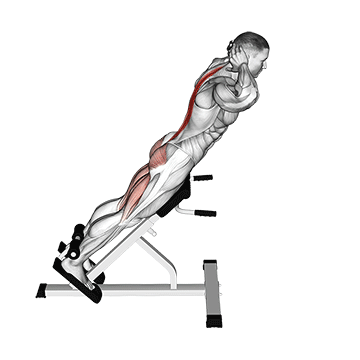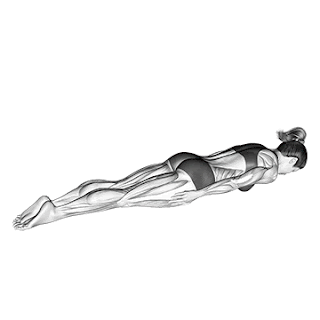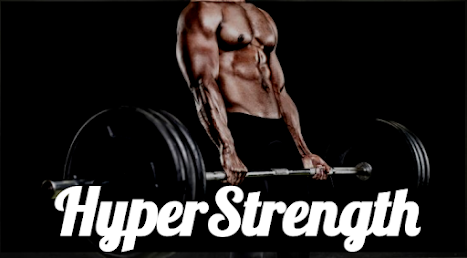
What are hyperextensions?
Hyperextensions are an exercise for developing muscles in the posterior chain. The main movers in the lower back are the spinal erectors, but the hamstrings, glutes and other back muscles are all activated.
This makes it a great movement for back development, strength gains, injury prevention and improved posture.
Hyperextensions are typically performed on a roman chair or hyperextension bench, but a flat bench or the floor can also be used if these are not available to you.
Which muscles are targeted with hyperextensions?

Hyperextensions are typically used to target lower back muscles. These are the spinal erectors and are activated whenever we straighten the spine. The spinal erectors start at the lower back and run all the way up the spine.
Although they do not provide much in the way of hypertrophy, developing them is essential for good posture, strength, and injury prevention.
All three spinal erectors work in tandem so are all heavily stressed with hyperextensions as the movement takes them from fully stretched positions to maximum contraction.
There are quite a few secondary muscles that are activated as secondary movers and stabilisers when performing hyperextension. The glutes and hamstrings come under strain on the upward movements along with the lats and core muscles.
Adding hyper-extensions to your routine will help to develop and strengthen all of these major movers in the posterior chain.
What are the advantages of adding hyperextensions to my routine?
Hyperextensions are essential for athletes and strength trainers as they strengthen the posterior chain. This will help to bring up the numbers on your pulling movements such as deadlifts.
Having strong spinal erectors will also help to prevent back injury while performing movements that overload the spine.
Bodybuilders will not see noticeable hypertrophy gains from performing hyperextensions but will gain improved posture and definition in the back. As before, they are also great for injury prevention if you place a lot of regular stress on the spine.
How do I do hyperextensions?
The easiest way to perform hyperextensions is on a dedicated bench. These allow you to tuck your legs in and the thigh pad takes the weight of your body. By using a dedicated hyperextension bench, you can lean right forwards and get the maximum range of motion from the movement.
Extra resistance can be added by holding a weight plate to the chest, using weighted chains, or putting a loaded barbell on your shoulders.

- Set up the bench so that you can tuck your lower legs in securely and the thigh pad sits on our upper legs but not too high up. You need stability, but you also need to be able to lean right forwards.
- Tuck your legs into the supports and lean on the thigh pads. Your spine should be straight with your legs and your arms folded.
- Take a deep breath as you lean forward. All the time, keep a straight back.
- Once leaned right forward, you are in the starting position. Erect the spine using your lower back as you breathe out. Use a slow and controlled motion so that you can feel the connection in your back.
- When you have fully erected the spine, repeat the movement for the required number of reps and sets.
Range of motion and strict form is of paramount importance with hyperextensions. Do not add any resistance until you can perform the exercise perfectly; otherwise, you risk injury.
Partial hyperextensions.
If you do not have great mobility, you can start by performing partial hyperextensions. These are performed in the same way as the regular version, but you do not bend as far over.
Your spinal erectors do not have the same range of motions, but they are still activated and contracted. Use this as a stepping stone and try to work your way up to a larger range of motion over a period of time.
Flat bench hyperextensions.
If your gym does not have a roman chain, you can use a flat bench to perform hyperextensions. If you want to get a full range of motion, you will need somebody to hold your legs down or wall-mounted support.
If you do not have these, you can perform a partial motion by having your lower torso still on the bench, but you will not get the full stretch of the spinal erectors.
Hyperextensions on the floor.
A variation of hyperextension can be performed on the floor, but the range of motion is very limited. There is not the option to lean forward at all, meaning that the only benefit is the contraction of the spinal erectors.
This exercise is great as part of a core circuit but should only be used if there is no roman chair or flat bench available.
Lower back extension machine.
The lower back extension machine allows you to perform the hyperextension movement from a seated position on a cable machine. The movement is the same as a hyperextension, although the glutes and hamstrings are not activated as highly.
This is a great machine for targeting the spinal erectors in the lower back. If you are planning a heavy deadlift session, using a lower back extension machine is the best way to warm-up and prepare the muscles that are usually at risk of injury.
Alternatives to hyperextensions.
There are a few other movements that activate and develop the spinal erectors and posterior chain. These can all be used as an alternative to hyperextensions, although none of them allows for such a wide ROM for the muscle group.
Superman.

A superman hold is a great option if you do not have access to a roman chair or flat bench. It is a variation of the floor-based hyperextension, but it requires you to lift your feet off the ground upon contraction allowing for a greater squeeze of the erectors.
Bridges.

Hip bridges are a great floor-based alternative or warm-up for hyperextensions. Although they predominantly activate the gluteal muscles, the spinal erectors are also engaged.
Take away
We hope that you have found this article informative and answered the question - what are hyperextensions?
Subscribe to our newsletter for great offers from leading supplement suppliers and to be alerted when new articles go live.
If you are looking to increase muscle mass rapidly, check out our FREE training split for natural lifters by clicking on the link below. This is a scientifically-backed, proven training program that uses optimal training frequency for each muscle depending on its fibre structure.
For those of you looking for strength gains, check out our HyperStrenght super-accumulation training strategy. This 3-week training program will teach you how to use measured overtraining for maximum strength gains.





.png)

